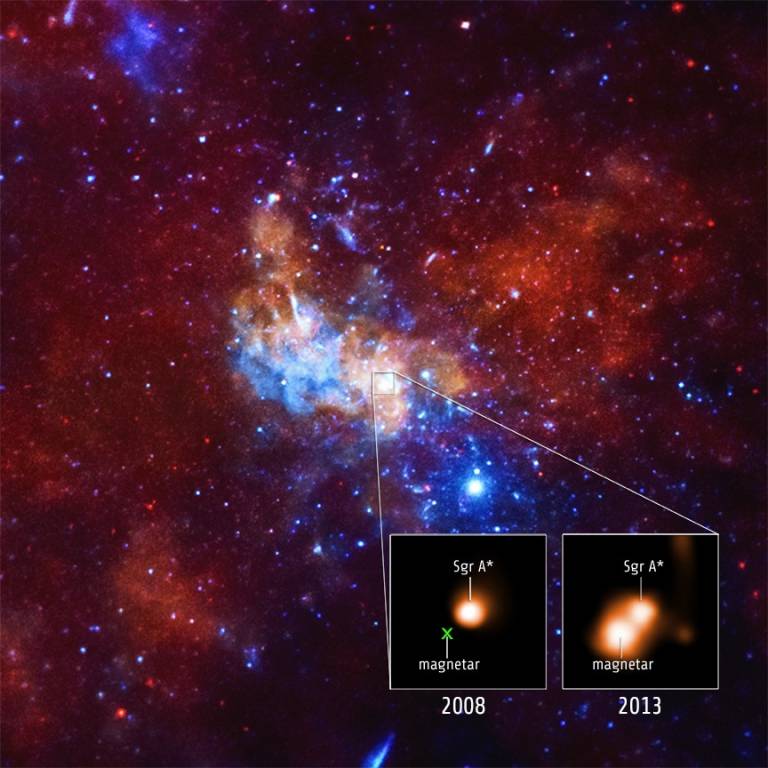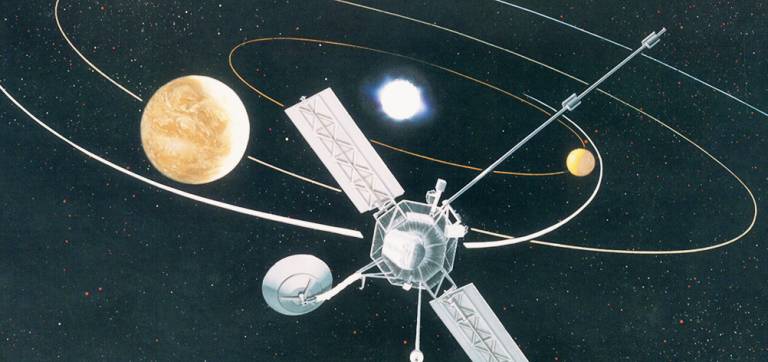Magnetar near supermassive black hole delivers surprises
14 May 2015

In 2013, astronomers announced they had discovered a magnetar exceptionally close to the supermassive black hole at the centre of the Milky Way using a suite of space-borne telescopes including NASA's Chandra X-ray Observatory.
Magnetars are dense, collapsed stars (called "neutron stars") that possess enormously powerful magnetic fields. At a distance that could be as small as 0.3 light years (or about 2 trillion miles) from the 4-million-solar mass black hole in the centre of our Milky Way galaxy, the magnetar is by far the closest neutron star to a supermassive black hole ever discovered and is likely in the black hole's gravitational grip.
Since its discovery two years ago when it gave off a burst of X-rays, astronomers have been actively monitoring the magnetar, dubbed SGR 1745-2900, with Chandra and the European Space Agency's XMM-Newton spacecraft. The main image of the graphic shows the region around the Milky Way's black hole in X-rays from Chandra (red, green, and blue are the low, medium, and high-energy X-rays respectively). The inset contains Chandra's close-up look at the area right around the black hole, showing a combined image obtained between 2005 and 2008 (left) when the magnetar was not detected, during a quiescent period, and an observation in 2013 (right) when it was caught as a bright point source during the X-ray outburst that led to its discovery.
A new study from a team including UCL's Silvia Zane has used long-term monitoring observations to reveal that the amount of X-rays from SGR 1745-2900 is dropping more slowly than other previously observed magnetars, and its surface is hotter than expected. The team first considered whether "starquakes" are able to explain this unusual behavior. When neutron stars, including magnetars, form, they can develop a tough crust on the outside of the condensed star. Occasionally, this outer crust will crack, similar to how the Earth's surface can fracture during an earthquake.
"Although starquakes explain the changes in brightness and temperatures observed in other magnetars, we discovered that they could not explain the behaviour of SGR 1745-2900," says Silvia Zane (UCL Mullard Space Science Laboratory). "This magnetar faded and cooled far slower than the starquake theory predicts. We think that the interaction of charged particles with the twisted magnetic field surrounding the magnetar is providing extra heat, and explains the slow decline in X-rays that we observed."
These twisted bundles of magnetic fields can be generated when the neutron star forms.
The researchers do not think that the magnetar's unusual behavior is caused by its proximity to a supermassive black hole, as the distance is still too great for strong interactions via magnetic fields or gravity.
Astronomers will continue to study SGR 1745-2900 to glean more clues about what is happening with this magnetar as it orbits our galaxy's supermassive black hole.
Notes
The study is published in a paper entitled "The X-ray outburst of the Galactic Centre magnetar SGR J1745−2900 during the first 1.5 year" by Coti Zelati et al., in the journal Monthly Notices of the Royal Astronomical Society.
Related links
- Paper in Monthly Notices of the Royal Astronomical Society (via arXiv.org)
- UCL Mullard Space Science Laboratory
-
Press release from NASA
High resolution image
Image credit: NASA/Chandra X-Ray Observatory (public domain)
Researcher profiles
Media contact
Oli Usher
UCL Faculty of Mathematical and Physical Sciences
020 7679 7964
o.usher@ucl.ac.uk
 Close
Close




